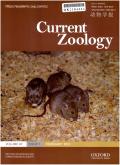Developmental instability, body mass, and reproduction predict immunological response in short-tailed bats
IF 2
2区 生物学
Q2 ZOOLOGY
引用次数: 0
Abstract
Developmental instability (DI) is a phenomenon whereby organisms are unable to buffer developmental disturbances, resulting in asymmetric variation of paired traits. Previous research has demonstrated a negative relationship between DI, measured as forearm asymmetry, and survival in the bat Carollia perspicillata. This study aims to test the hypothesis that individuals with higher DI exhibit a lower immune response. We measured a delayed-type hypersensitivity to the antigen phytohemagglutinin (PHA) on 74 males and 65 females of C. perspicillata before and after the breeding season. Linear models were used to predict the immunological response based on body mass, forearm asymmetry, sex, breeding season, and testicle length. The best-fitting model accounted for 29% of the variation in immune response and included asymmetry, body mass, sex, and breeding season as predictors. The immune response was negatively associated with asymmetry and testicle length in males, but positively related to asymmetry in females. Both sexes showed a reduced immune response in the late breeding season. Additionally, the association between immune response and body mass changed direction seasonally, with heavier individuals showing weaker responses early in the breeding season and stronger responses later. Individual variation in male immunity was predicted by individual attributes, whereas variation in immune response in females was mostly seasonal. Our results support the link between DI, survival, and immune response in short-tailed bats, and suggest that the immunological component measured by the PHA response may be under finer selection in males due to its stronger correlation with individual traits.发育不稳定、体重和繁殖可预测短尾蝠的免疫反应
发育不稳定性(DI)是生物体无法缓冲发育干扰的一种现象,它导致成对性状的不对称变异。先前的研究表明,以前臂不对称度衡量的发育不稳定性与蝙蝠 Carollia perspicillata 的存活率之间存在负相关。本研究旨在检验 DI 值越高的个体免疫反应越低的假设。在繁殖季节前后,我们测量了 74 只雄蝙蝠和 65 只雌蝙蝠对抗原植物血凝素(PHA)的迟发型超敏反应。根据体重、前臂不对称、性别、繁殖季节和睾丸长度,采用线性模型预测免疫反应。最佳拟合模型可解释 29% 的免疫反应变化,其中包括不对称度、体重、性别和繁殖季节。雄性的免疫反应与不对称性和睾丸长度呈负相关,而雌性则与不对称性呈正相关。在繁殖季节后期,雌雄睾丸的免疫反应都有所降低。此外,免疫反应与体重之间的关系随季节而变化,体重较大的个体在繁殖季节早期免疫反应较弱,而在繁殖季节后期免疫反应较强。雄性个体免疫反应的个体差异是由个体属性预测的,而雌性个体免疫反应的差异主要是季节性的。我们的研究结果支持短尾蝠的DI、存活率和免疫反应之间的联系,并表明用PHA反应测量的免疫成分可能在雄性个体中受到更精细的选择,因为它与个体特征的相关性更强。
本文章由计算机程序翻译,如有差异,请以英文原文为准。
求助全文
约1分钟内获得全文
求助全文
来源期刊

Current Zoology
Agricultural and Biological Sciences-Animal Science and Zoology
CiteScore
3.20
自引率
9.10%
发文量
111
审稿时长
6 weeks
期刊介绍:
About the Journal
Current Zoology (formerly Acta Zoologica Sinica, founded in 1935) is an open access, bimonthly, peer-reviewed international journal of zoology. It publishes review articles and research papers in the fields of ecology, evolution and behaviour.
Current Zoology is sponsored by Institute of Zoology, Chinese Academy of Sciences, along with the China Zoological Society.
 求助内容:
求助内容: 应助结果提醒方式:
应助结果提醒方式:


